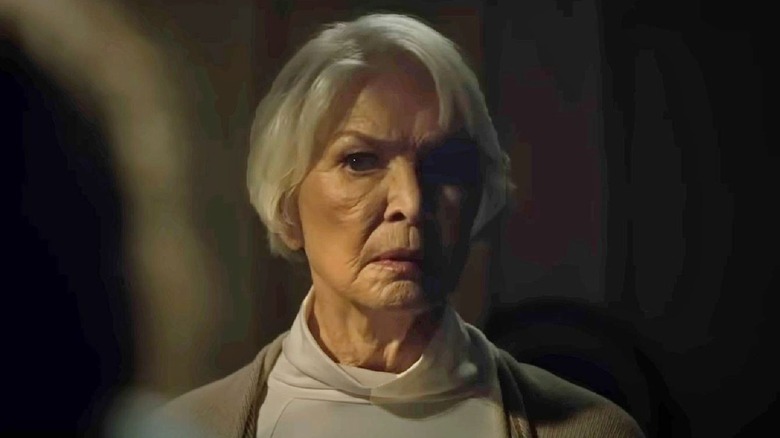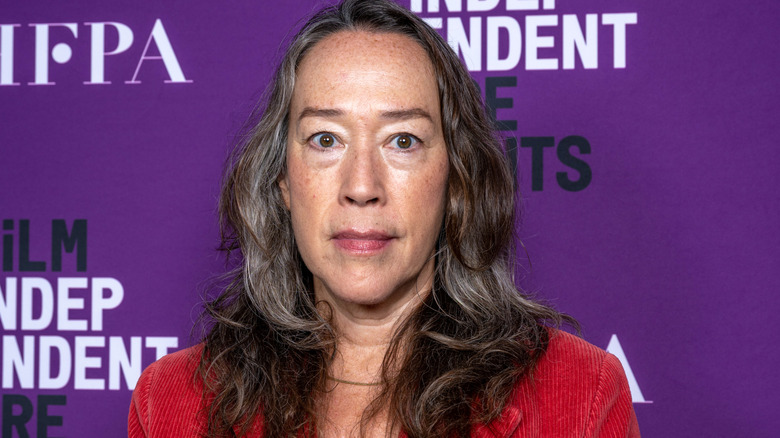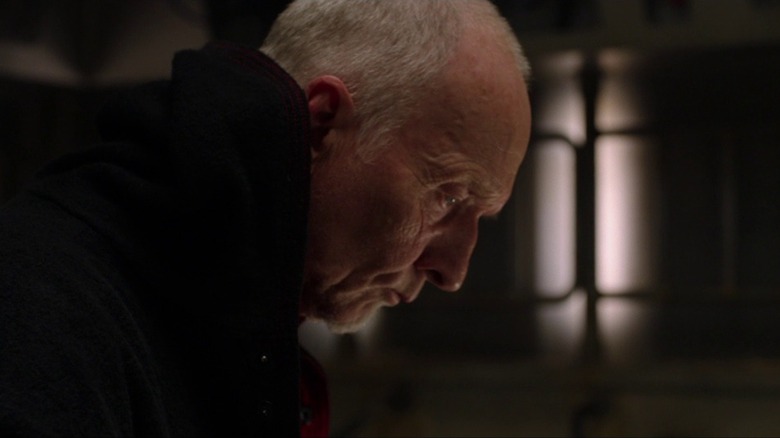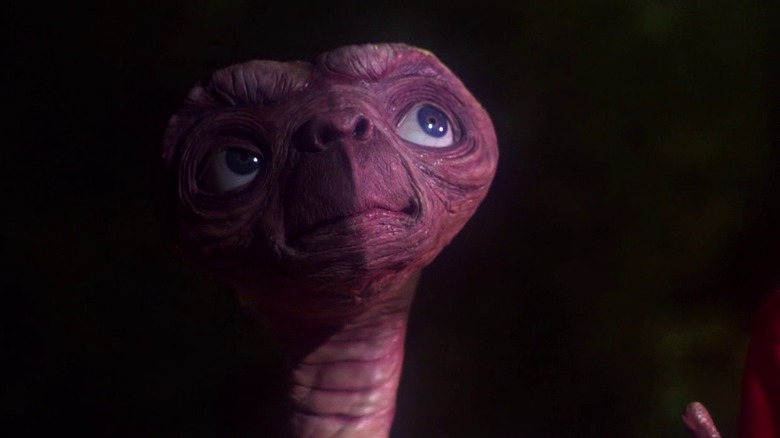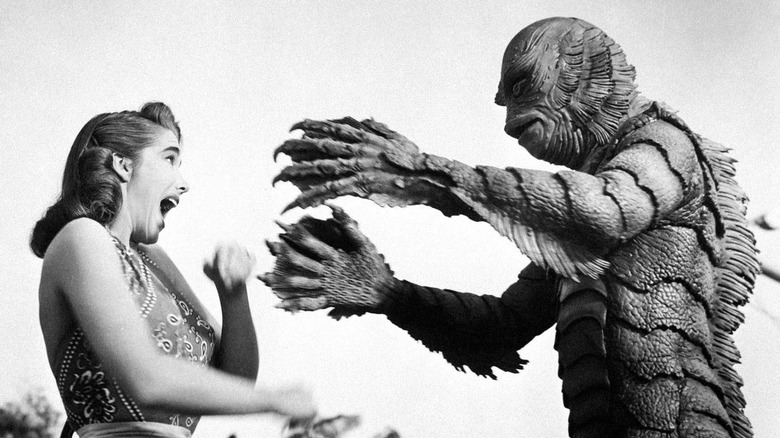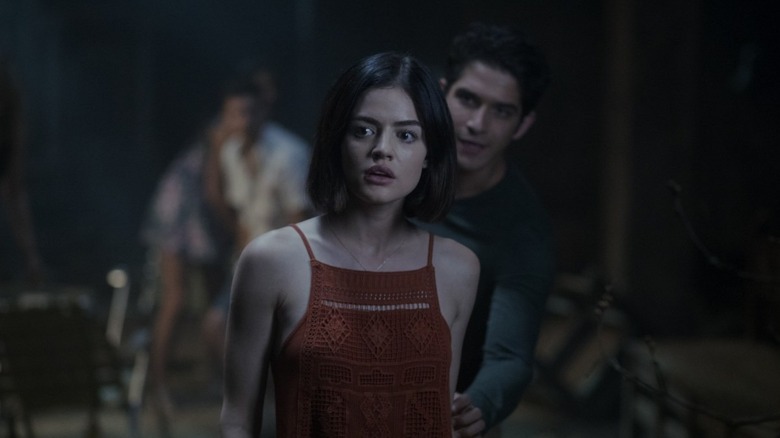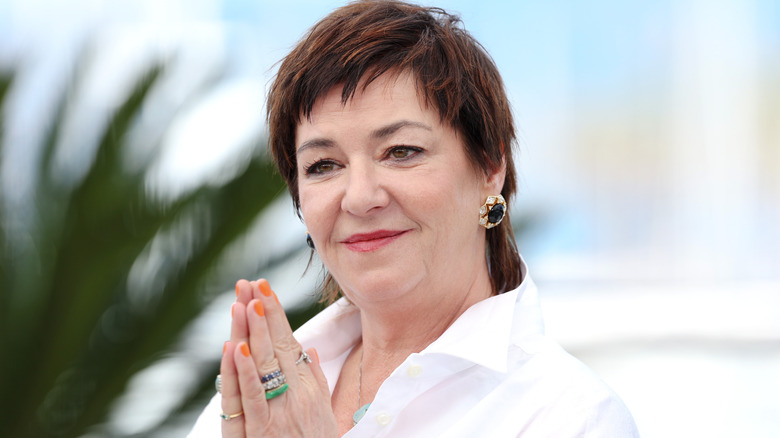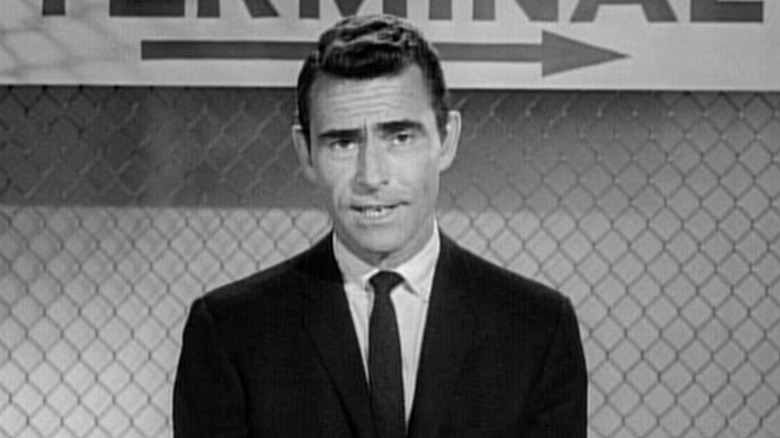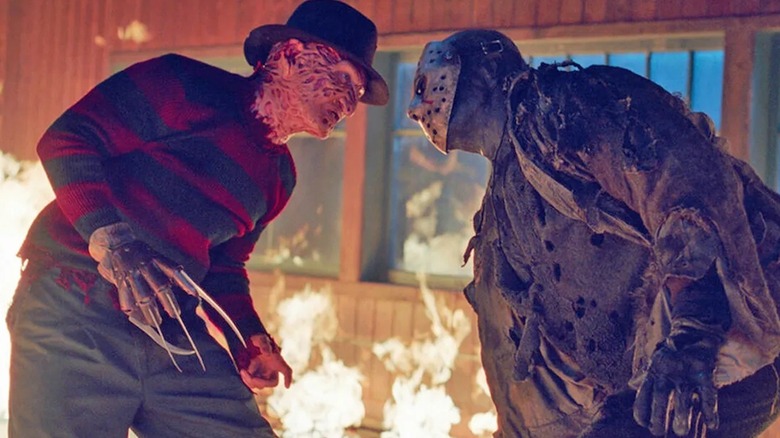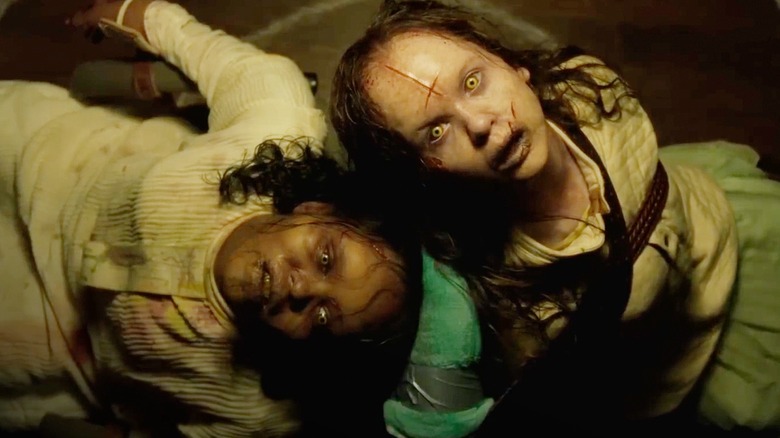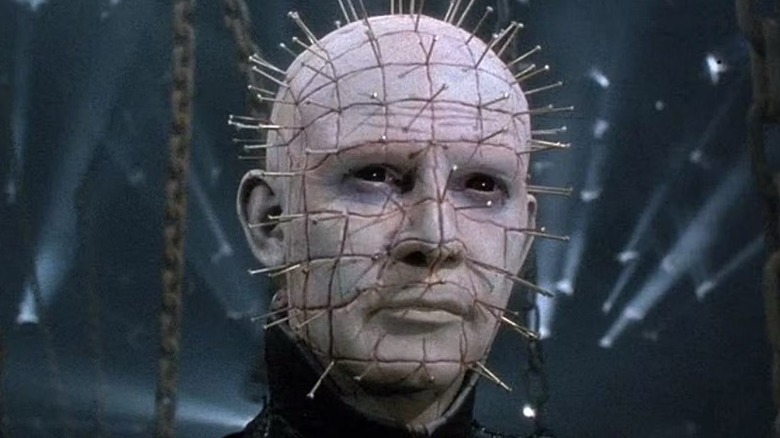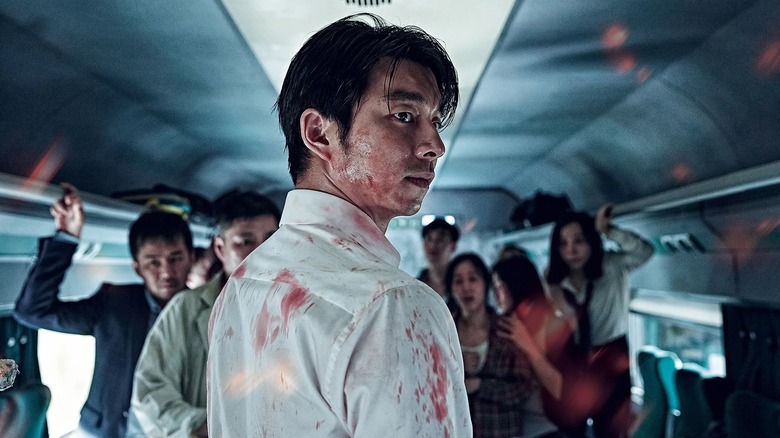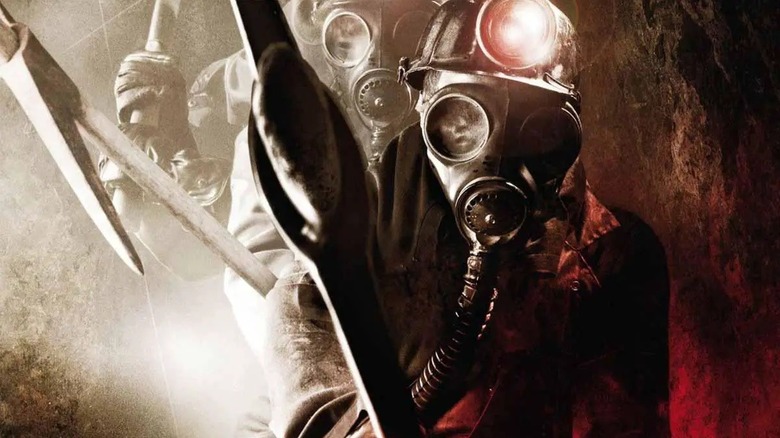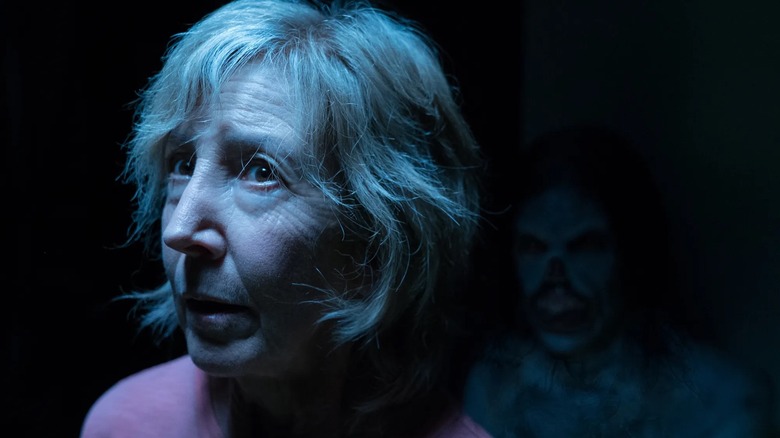16 Canceled Horror Movies We'll Never See
There are so many horror movies produced every year that it's hard to imagine any pitches for fresh entries in the genre getting rejected. Surely, Blumhouse, A24, Sony/Screen Gems, and executives from other mainstays of American horror cinema just greenlight every script that crosses their path in the hopes of producing the next "Longlegs" or "Get Out."
Of course, that's obviously not true. Horror, like any other genre, yields tons of productions that have splashy announcements and potential, but never materialize on the silver screen. Even in the more prolific realm of low-budget productions, horror movies can fall apart, while even well-known directors like Lynne Ramsay, Guillermo del Toro, Karyn Kusama, and others don't always have the clout to get their passion projects to the finish line.
These 11 canceled horror movies, in particular, reflect the precarious road to getting any entry in this genre off the ground. Everything from challenging big-budget H.P. Lovecraft adaptations to remakes of famous Universal Monsters characters can fall apart in the treacherous world of horror cinema. There's no uniform reason for these 11 projects crumbling. Each carries a unique story regarding its respective ambitions and demise. But they all share the common threads of unfulfilled potential and glorious commitment to their genre. Much like any good slasher villain or Final Girl, these canceled horror movies refuse to die.
Mina Harker
2009's "Jennifer's Body" announced Karyn Kusama as a genre director for movie fanatics to watch. Plus, as anyone who's seen her other works like "Destroyer" and "The Invitation" can attest, Kusama's talents aren't just confined to that Megan Fox star vehicle. She's got a sharp eye for great visuals and compelling tones that grip viewers from frame one. so the prospect of her adapting Bram Stoker's "Dracula" sounds like it could have been a horror movie for the ages.
Tragically, this production, titled "Mina Harker" and set to star the incredible Jasmine Cephas Jones in a modern-day version of the title role, collapsed just weeks before shooting was supposed to begin. Two years after the project fell apart, Kusama suggested that the plug was pulled on her ambitious take because it would not have been a standard monster movie.
Because "Mina Harker" was audacious enough to try something different (right down to its title, indicating that the focus would have been on the leading lady of Stoker's novel), Kusama suspected that studio executives began fretting. That led to the production shutting down only three weeks before cameras would have started rolling. No further reports emerged on which actors or key crew members (like cinematographers and composers) were attached to the project, but just the idea of Kusama breathing radical new life into the story of Dracula sounded like a match made in heaven, a vision that should have been allowed to come to fruition.
At the Mountains of Madness
After his "Hobbit" duology plans were scuttled, director Guillermo del Toro moved forward on a profoundly personal passion project of his. Del Toro had long loved H.P. Lovecraft's "At the Mountains of Madness" and had yearned for a chance to bring it to the silver screen. Once it was clear his take on "The Hobbit" wasn't happening, del Toro immediately pounced on a chance to make a big-budget R-rated version of the story for Universal Pictures. This incarnation of "Madness" teamed del Toro with two titans of the blockbuster cinema world, producer James Cameron and leading man Tom Cruise. It also would have given the "Cronos" helmer more resources and money than he'd ever had access to before in his career.
While a summer 2011 principal photography start was initially on the cards, this was not meant to be. By March 2011, del Toro confirmed that Universal had become skittish over investing so much money into a horror film that had a restrictive R rating. This development led to the production collapsing and del Toro pursuing other projects like "Pacific Rim" instead. Del Toro's fervor for "At the Mountains of Madness" hasn't dimmed in the years since, with the filmmaker even pitching a lower-budgeted adaptation to Netflix in recent years. However, the original, costly iteration of del Toro's "At the Mountains of Madness" will never see the light of day.
Jigsaw
After "Saw 3D" in 2010, the "Saw" franchise shut down, at least for a little while, after previously delivering new installments annually. With a significantly lengthier gap between "Saw 3D" and whatever came next, something drastic was needed to get audiences re-invested in this grisly, blood-stained world.
Screenwriters Josh Stolberg and Peter Goldfinger originally proposed a version of the 2017 film "Jigsaw" that would have taken the saga's default style in a whole new direction. Specifically, Stolberg and Goldfinger wanted to isolate John Kramer's (Tobin Bell) captives by setting all the traps on an oil derrick. These poor souls would not be fighting for their lives in an empty warehouse, but out in the middle of the ocean with nothing nearby.
There were certainly chilling possibilities in that concept, particularly in how it would have added new obstacles once people got free of the traps. This could have also signaled to viewers that the "Saw" franchise wasn't intent on just repeating itself. Frustratingly, Stolberg and Goldfinger recalled that Lionsgate leadership immediately nixed that concept, so the pair went back to the drawing board until they came up with something much closer to the original seven movies in scope and style. For a brief moment, though, it looked like the "Saw" franchise might have embraced changes that would have given John Kramer's world of death an extra dose of life.
Night Skies
In 1982, "E.T. the Extra-Terrestrial" turned a funky-looking, long-necked alien into America's sweetheart. People all over the world couldn't get enough of this critter, but Steven Spielberg's wholesome family adventure had significantly more sinister origins.
"E.T." initially started life as a dark, quasi-"Close Encounters of the Third Kind" sequel that would have followed a rural family terrorized by a bunch of aliens. No less than "The Texas Chain Saw Massacre" helmer Tobe Hooper was onboard to direct the film, while visual effects tests were underway for the practical wizardry that would be used to realize the creatures. Though there was potential in this premise, producer Spielberg grew disillusioned with the project as he yearned for something a little more soulful. The terror of "Night Skies" did not fit that bill.
Eventually, Spielberg focused on a friendlier "Night Skies" alien named Buddy, who befriends a human child in the story. This was the character that would become "E.T.," as the project evolved into something radically different and more family-friendly. "Night Skies" faded to black, while Spielberg started from scratch on a more pathos-driven story about just one alien encountering the human race. Hooper and Spielberg, meanwhile, would finally unite on the horror hit "Poltergeist," and decades later, Spielberg would realize his concept of a family navigating a nefarious alien invasion with "War of the Worlds." Even if it never came to the big screen itself, "Night Skies" proved a bountiful creative wellspring for three classic movies.
Creature from the Black Lagoon
The Gill-Man from 1954's "Creature from the Black Lagoon" remains one of the most enduring figures in both the Universal Monsters canon and American horror cinema. Given that the character scored a handful of sequels in the 1950s, and that Universal Pictures loves remaking its old monster movies into modern outings like "Wolf Man" and "The Invisible Man," a "Creature from the Black Lagoon" remake should be a no-brainer to terrorize 21st-century moviegoers.
Despite countless efforts to develop this project, however, a new iteration of "Black Lagoon" has never materialized. One version that came especially close to existing hailed from "Sahara" director Breck Eisner. The director's comments about the project's scope and scale in 2008 suggested that Eisner and Universal brass were hoping to turn "Creature from the Black Lagoon" into a blockbuster on par with 1999's "The Mummy."
By 2009, though, all the best-laid "Black Lagoon" plans (which included practical filming in the Amazon) had gone awry. Eisner left the project that year and suddenly chaos consumed the endeavor. For a moment, Universal courted subsequently notorious filmmaker Carl Rinsch to take over the film, but this never panned out. Universal soon shifted focus to other modern monster movies like "Dracula Untold" and 2017's "The Mummy." "Creature from the Black Lagoon," despite its enduring popularity and influence on pop culture (just look at 2017's "The Shape of Water"), sank to the bottom of Universal's priorities for horror movie remakes.
Truth or Dare 2
Though it made a shocking amount of money in its spring 2018 theatrical run ($95.3 million dollars, to be precise), director Jeff Wadlow's Blumhouse horror title "Truth or Dare" didn't leave much of an impact culturally. While Blumhouse has spun endless franchises out of movies like "Paranormal Acitvity" and "The Purge," "Truth or Dare" has endured as a largely forgotten one-off.
However, for one brief moment in time, there were ambitions to get an unusual sequel off the ground. While promoting his 2024 feature "Imaginary," Wadlow revealed that a script had been conjured up for a "Truth or Dare 2" that went in a meta-"Wes Craven's New Nightmare"/"Scream 3" direction for the saga. The plot would have concerned the real "Trurth or Dare" actors, playing themselves, going on vacation only for the supernatural "Truth or Dare" shenanigans to begin befalling them.
This production, titled "Truth or Dare IRL," almost began shooting on a Universal backlot during the early months of COVID-19. However, Wadlow claimed that the costs of filming during the pandemic made it unfeasible, especially considering both Blumhouse's budget-conscious filmmaking model and the original film's $3.5 million price tag. Though Wadlow and other "Truth or Dare" personnel look back on the concept fondly, don't expect this follow-up to bounce back from the dead: Everyone involved feels that too much time has passed for the project to work. With this inventive sequel a no-show, "Truth or Dare" truly has no hope of escaping its muted reputation.
The Girl Who Loved Tom Gordon
"We Need to Talk About Kevin" mastermind Lynne Ramsay has become one of the best English-language filmmakers alive today thanks to her gift for realizing haunting, harrowing cinema that gets under your skin. Her works often keep the most unspeakable parts of humanity off-screen, yet their impact and how on-screen characters react to these atrocities still shakes moviegoers to their core.
In late 2020, it looked like Ramsay was preparing to apply her craft to more mainstream material through adapting the Stephen King novel "The Girl Who Loved Tom Gordon." This 1999 novel focused on nine-year-old Trisha McFarland, who becomes lost on the Appalachian Trail with only her recurring visions of Red Sox player Tom Gordon to accompany her in this treacherous realm. In other words, this book provided a perfect story for Ramsay to continue exploring tormented youths as she'd done in "Ratcatcher" and "We Need to Talk About Kevin."
Announced just three years after 2017's "It" made King adaptations a hot cinematic commodity again, the project would have teamed indie auteur Ramsay with mainstream Hollywood producer Roy Lee, best known for producing "The Lego Movie," the two "It" films, and "Barbarian," among many others. Despite bringing together King, Lee, and Ramsay, no further updates ever emerged on the adaptation. Instead, it was announced in 2025 that "Strange Darling" writer-director JT Mollner had been tapped by Lionsgate to write a new version of "The Girl Who Loved Tom Gordon."
Bride of Frankenstein
Given that Frankenstein's monster is one of the most famous Universal Monsters creations, it's no surprise that the Dark Universe (an aborted 2010s attempt to reboot those monsters in a modern context) opted to make its second planned film a "Bride of Frankenstein" remake. This project would have been helmed by Bill Condon, who previously directed the feature "Gods and Monsters," which chronicled the later years of original "Bride" director James Whale.
Set to hit theaters on Valentine's Day 2019, the new "Bride of Frankenstein" would have featured Javier Bardem as Frankenstein's monster, with Condon eyeballing Angelina Jolie for the title character. However, once the first Dark Universe entry, "The Mummy," cratered in June 2017, Condon's take on "Bride of Frankenstein" was quickly put on ice. Two years after it was shelved, Condon explained that budgetary concerns led to his "Bride of Frankenstein" going nowhere, an outcome that left him devastated.
By February 2020, Universal began implementing a lower-budgeted approach to its classic monsters with "The Invisible Man," which continued with "Wolf Man." However, "The Bride of Frankenstein" still hasn't received the remake treatment. With Condon's incarnation long-perished (and rival projects like "The Bride!" preparing to hit theaters), perhaps a "Bride of Frankenstein" remake "belongs dead," as Frankenstein's monster would say.
The Twilight Zone
The original "Twilight Zone" TV show that premiered in October 1959 ran for a whopping 156 episodes, while a 1980s revival managed a respectable 65 episodes. When it comes to vintage iterations of "The Twilight Zone," there was no end to the possibilities for a program that could offer viewers a new standalone, creepy tale each week. But surprisingly, even just getting another "Twilgiht Zone" theatrical movie (following the mid-1980s adaptation) off the ground has been a challenge.
In the late 2000s, a 21st-century "Twilight Zone" movie reboot gained some momentum as Leonardo DiCaprio stepped aboard to produce the project for Warner Bros. Pictures. Shortly afterward, director Matt Reeves, fresh off 2008's hit "Cloverfield," signed on to direct this ambitious reimagining of a television classic. Reeves wouldn't last long on the project, however, as the siren song of "Dawn of the Planet of the Apes" beckoned him to other blockbuster pastures.
Another major filmmaker, future "Top Gun: Maverick" helmer Joseph Kosinski, signed on to direct "Twilight Zone" instead. But even with this potentially exciting development, no further news emerged about the adaptation. Perhaps the eventual 2010s horror landscape — dominated by cheaper Blumhouse films and "Conjuring" sequels — just didn't have room for a big-budget interation of "The Twilight Zone," despite its longevity.
Freddy vs. Jason vs. Ash
In August 2003, horror icons Freddy Krueger and Jason Voorhees went toe-to-toe for the first time in "Freddy vs. Jason." Directed by Ronny Yu, the sight of two slasher legends trying to slaughter each other generated excitement — and box office — among horror fans. But a third horror icon could have entered this showdown in a sequel.
After various "Friday the 13th" comic books and movie-based Easter eggs suggested that Jason was a Deadite from Sam Raimi's "Evil Dead" saga, it was proposed that the latter's protagonist, Ash Williams (Bruce Campbell), get in the ring in "Freddy vs. Jason vs. Ash." Just as the entire "Alien vs. Predator" concept originated in a Dark Horse comic book, this notion first came to the public eye through a six-issue comic series published by DC Comics. Those comic writers weren't the only ones to like this notion, though, as Bruce Campbell has often recalled that New Line Cinema called him to discuss making this crossover a reality.
While Campbell wasn't opposed to the concept, he was immediately turned off when New Line Cinema executives told him that the crossover couldn't do anything that would destroy either Freddy or Jason. Jeopardizing potential standalone films for these characters was a no-go, which is why Campbell immediately dismissed the entire concept as emblematic of why big pop culture crossovers rarely work. With that, "Freddy vs. Jason vs. Ash" was dead in the water.
The two Exorcist: Believer sequels
Universal made jaws drop across Hollywood in July 2021 when it shelled out $400 million to Blumhouse Productions and Morgan Creek Entertainment for the distribution rights to three new "Exorcist" movies. Even given the combined $491 million that Blumhouse's three "Halloween" films scored for Universal, that price tag for new "Exorcist" movies was bamboozling.
Unsurprisingly, after spending all that dough, Universal immediately committed to making as many "Exorcist" movies as possible. With "The Exorcist: Believer" launching in October 2023, the hope was that "Believer" director David Gordon Green (who previously directed all the Blumhouse "Halloween" trilogy) would quickly follow it up with two more "Exorcist" entries. The first of those, "The Exorcist: Deceiver," got a prime April 2025 release date three months before "Believer" even hit theaters.
Alas, getting too confident in the public's hunger for more of "The Exorcist" ended up backfiring on Universal. While "The Exorcist: Believer" did make a profit theatrically, it came in way under pre-release box office expectations. Its general response from critics and audiences was also tepid enough to suggest that people weren't immediately craving more "Exorcist" titles. A few months after the release of "Believer," Green left this series and the two "Believer" sequels were scrapped, with a totally separate "Exorcist" installment from writer-director Mike Flanagan now in development to get this franchise back on track. Whatever happens, now Universal knows that $400 million can't automatically buy audience enthusiasm.
Saw XI
Back when the "Saw" franchise was at its peak, this saga could crank out a new film every year without breaking a sweat. It was an insane process that yielded six sequels to 2004's micro-budget "Saw" in just over six years. So one would imagine that producing a follow-up to 2023's moneymaker "Saw X" would be easy as pie. After all, the film reaffirmed that this saga could still go the financial distance decades after Jigsaw (Tobin Bell) started his nefarious games. However, "Saw XI" is apparently chained to a radiator in a grimy room somewhere.
Originally, Lionsgate had hopes to get "Saw XI" out just one year after "Saw X," in September 2024, mirroring the release strategy of the first wave of Saw" titles. However, it was eventually delayed to September 2025, and six months before its planned release date, word broke that creative disagreements had derailed the project. Screenwriter Patrick Melton later divulged that the production had been at a standstill since spring 2024. Apparently, Lionsgate and the "Saw" producers couldn't agree on which direction to take "Saw XI" in.
Despite Melton being passionate about the politically relevant themes his and co-writer Marcus Dunstan's script tackled, it wasn't enough to get this follow-up off the ground. Blumhouse purchasing the "Saw" rights makes it clear that further entries in this franchise are coming, but wherever the saga goes next, it certainly won't involve this initial iteration of "Saw XI."
Hellraiser
Among the many horrific sights Pinhead shows to mortal humans must be the grim direction that the "Hellraiser" franchise has taken over time. Those first two "Hellraiser" films were spectacularly unhinged, gnarly descents into psychosexual chaos. But 21st century direct-to-video sequels like "Hellraiser: Hellworld" and "Hellraiser: Revelations" turned the property into a joke. Dimension Films, which held the rights to the franchise for many years, just cranked out the worst movies to either make a quick buck or hold on to the property.
One of the unexplored ambitions Dimension Films had for "Hellraiser" was for a full-fledged reboot from director Parick Lussier, who had plenty of experience working for the studio as a director and editor on titles like "Dracula 2000" and the original "Scream" trilogy. Lussier's vision would have explored new ground in the saga by going back to the very beginning of Pinhead's existence. Further drafts from Lussier went in the opposite direction by working as direct follow-ups to the original "Hellraiser," with one iteration of the project even featuring Pinhead passing on his duties to a new soul.
There was clearly a lot of uncertainty over what the heck a new "Hellraiser" should even look like. Still, Lussier hoped to make something that lived up to the creative passion Clive Barker imbued into the original "Hellraiser." Unfortunately, those good intentions never resulted in a fully-finished motion picture.
The Last Train to New York
It's hard to imagine anyone finishing director Yeon Sang-ho's emotionally devastating, transfixing 2016 horror film "Train to Busan" and thinking, "That was pretty good ... but it would've been better if it was in English." That's just the thought process, however, that launched plans for an English-language remake titled "The Last Train to New York." Acclaimed filmmaker Timo Tjahjanto was set to direct the movie – a collaboration between Warner Bros./New Line Cinema and James Wan's Atomic Monster – and an early 2023 release was planned.
Wan's specific idea for the remake was that it would take place in the "Busan" universe and occur parallel to the original film's storyline. In other words, "New York" wasn't replacing a beloved horror classic, but rather expanding its universe. Though Wan expressed his enthusiasm for the project as late as June 2025, it's doubtful the film will happen anytime soon. For one thing, with each passing year, "Train to Busan" gets a little bit less relevant in the cultural conversation. That means there's less money for American movie studios to exploit in cashing in on its brand name and aesthetic.
Meanwhile, Tjahjanto is incredibly in demand as a filmmaker now and has projects like "The Beekeeper 2" on the horizon. Between all that, it's doubtful there's any room in the near future for "The Last Train to New York" to pull into a theater near you.
My Bloody Valentine 3D 2
Opening in the earliest weeks of 2009, "My Bloody Valentine 3D" (a remake of the 1981 film of the same name) benefited tremendously from timing. For one thing, its mid-January release date allowed it to run for multiple weeks before Valentine's Day actually arrived. This Patrick Lussier directorial effort also debuted early enough into the late 2000s digital 3D resurgence that being released in this format still had some novelty. Given that this project was an indisputable moneymaker and distributor Lionsgate loves milking horror franchises like "Saw" for as long as possible, it's staggering that there wasn't another sequel.
It turns out, however, that Lussier and screenwriter Todd Farmer both had ambitions for a follow-up. The concept would have been to dive deeper into the lore of the "My Bloody Valentine 3D" universe. Initial protagonist Sarah (Jaime King) would have bitten the dust in the sequel, a sign that nothing was truly off-limits and that anyone could die. Lionsgate never showed much interest in this concept, though, and it quickly withered away as Lussier turned his attention to other projects like "Drive Angry."
Given that the digital 3D fad largely vanished by 2014 in the U.S., it's doubtful "My Bloody Valentine 3D 2" could have mimicked its predecessor's box office success. Still, Lussier and Farmer coming up with concepts for such a project only confirms the horror genre's love for unending sequels.
Insidious/Sinister
Horror movie crossovers have always been a very popular phenomenon. Frankenstein and Dracula used to contend with each other back in the classic Universal Monsters era, while "Puppet Master vs. Demonic Toys" intertwined two cheeseball Full Moon Features franchises. Blumhouse Productions has largely resisted this siren call so far and has not crossed "Purge" over with "Five Nights at Freddy's." However, producer Jason Blum once teased such a production in the form of an "Insidious" and "Sinister" crossover entitled "Insinister."
These two titles didn't share creative teams, nor were there previous clues in "Sinister" or "Insidious: The Last Key" indicating that they were secretly in the same universe. However, Blum was convinced that these two franchises would eventually collide and considered it as inevitable as the sun rising each morning. Presumably, the impetus for these sagas bumping into each other was because they were both heavily centered on supernaturally possessed children. Their creaky, eerie sound designs also somewhat echo each other.
Years later, Blum, while promoting "Insidious: The Red Door," confirmed that the project had struggled to come together. That's not surprising, solely because the "Sinister" franchise has now been dormant for a decade. While "Insidious" keeps cranking out new installments, crossing it over with "Sinister" in the modern pop culture landscape would just be random and appealing to nobody. What seemed so inevitable back in 2017 is now a weird time capsule of how crossovers are always on the mind of horror movie producers.
